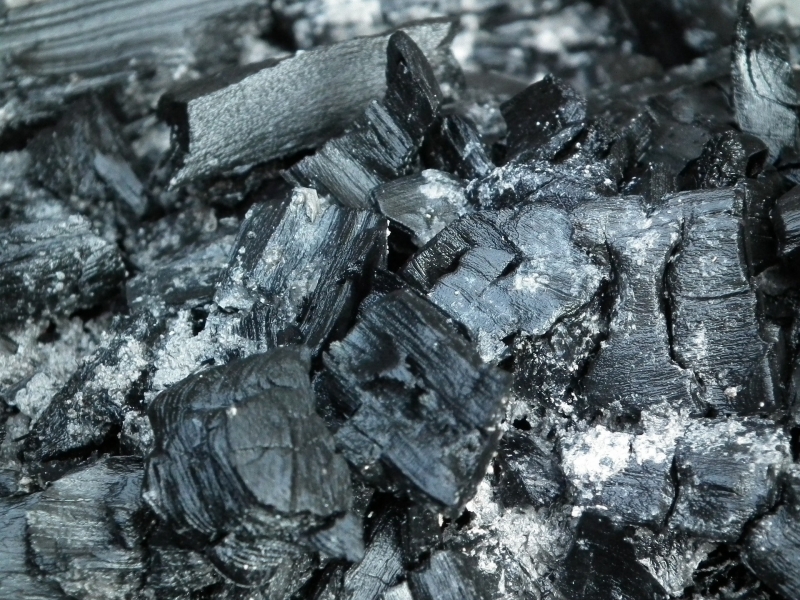Since the beginning of the Industrial Revolution, coal-fired systems have been emitting a pollutant we did not even know existed . . . until now. In 2014, a team of scientists studying arsenic in the Dan River coal ash spill site in North Carolina discovered a new nano-scale version of titanium oxides that had never been seen before.* What they discovered were titanium suboxides, or so-called Magnéli phases, which were first synthesized in the 1930s. These substances are extremely rare in nature, seen only in rocks having an extraterrestrial origin (meteorites, lunar rocks, and interplanetary dust particles), and at one known point on the earth’s surface—rock formations on the central coast of western Greenland.
 |
The story became more interesting. The more they looked, the more they found. The team tested 21 additional coal ash samples from 12 coal-fired plants in the United States (Kentucky, Missouri, New Mexico, Texas, and Virginia) and China (Chongquin and Yunnan). Electron microscopy found evidence of titanium suboxide particles in every ash sample tested (the most common form was Ti6O11). The Magnéli phase particles existed in a variety of sizes, many of which were under 100 nanometers in diameter. Assuming that particles of this size could easily travel in wind currents, they expanded the search radius and found evidence of the particles in an urban storm water pond, a lake, and in road dust in a Chinese urban area. This was like digging around and unexpectedly finding some bone that shifts a few branches on the evolutionary tree or changes our notions of who we are and how we got here.
It is important to keep in mind two important characteristics of nano-scale materials. First, as we approach a threshold of around 100 nanometers, the properties of materials—optical, thermal, electrical or chemical—often change, and change radically. Gold, for instance, which we associate with a yellow color in its bulk form, reflects red light in the 30-nanometer range and can shift from inert to highly reactive. Second, nano-engineered materials operate at the scale of biological systems, allowing these materials to move in humans and animals in novel ways, for instance, penetrating deep into the lungs or crossing the blood-brain barrier.
Any nano-scale ubiquitous material can raise human and ecological health issues. To estimate the potential toxicity of titanium suboxides, the scientists used a common test that employs zebrafish embryos. Testing found that unlike normal titanium dioxide, which is photoactive and damaging to zebrafish embryos in sunlit conditions, these particles were reactive and toxic to zebrafish in dark conditions, which has significant implication for humans inhaling particles into the dark depths of their lungs.
A wider search into possible sources of titanium suboxides also found that they can be produced through other processes that burn coal or coke at high temperatures, such as steel production or smelting. One obvious question, given the multiplicity of sources and persistence of the material, is just how much has been emitted into the earth’s atmosphere since the beginning of the Industrial Revolution? Back-of-the-envelope calculations result in a figure of around one billion tonnes or, for comparison, the equivalent of 200 million elephants, which would stretch from the earth to the moon—tail to trunk.
The environmental and health impacts of these materials going forward will depend on our policies and practices. Modern coal-fired power plants employing particulate traps have stopped contributing to these emissions. The U.S. Environmental Protection Agency (EPA) updated the national ambient air quality standards in 2013 to provide increased protection against particulates in the size range below 2.5 microns (PM2.5). In addition, in 2016, EPA finalized national regulations to provide for the safe disposal of coal combustion residuals from coal-fired power plants. But in many countries, like China and India, power plants lack adequate filtration systems or procedures for the safe disposal of combustion products. The World Health Organization estimates that air pollution is responsible for 3.3 million premature deaths worldwide, annually, with 1.6 million occurring in China alone, so the appearance of any newly discovered airborne particle has potentially large implications.
That is why understanding the long-term toxic effects of titanium suboxides to humans is important and will require much more study into their transport and fate, mechanisms of action, and short- and long-term impacts from exposures. Interestingly, given the rarity of Magnéli particles, they could be used as an effective tracer to track anthropogenic global emissions from coal-fired power plants.
This story serves as an important reminder of how scientific research can lead to unscripted discoveries. We have already been caught off guard by instances where nanomaterials that were engineered to solve one problem create another. For instance, nano-scale silver particles developed as antimicrobials for clothing impacted wastewater treatment plants after laundering, and nano cerium oxide developed to increase the fuel efficiency of diesel engines and reduce emissions became themselves a potentially problematic emission.
Titanium suboxides result in impacts that are unintentional and incidental rather than engineered. There are certainly more surprises of this type that await discovery as well as those that will be of our own making.
* Hochella, M. & Yang, Y. 2017. “The Emerging Field of Nano-Environmental Science,” Pan European Networks: Sci. & Tech., Vol. 24, forthcoming.
